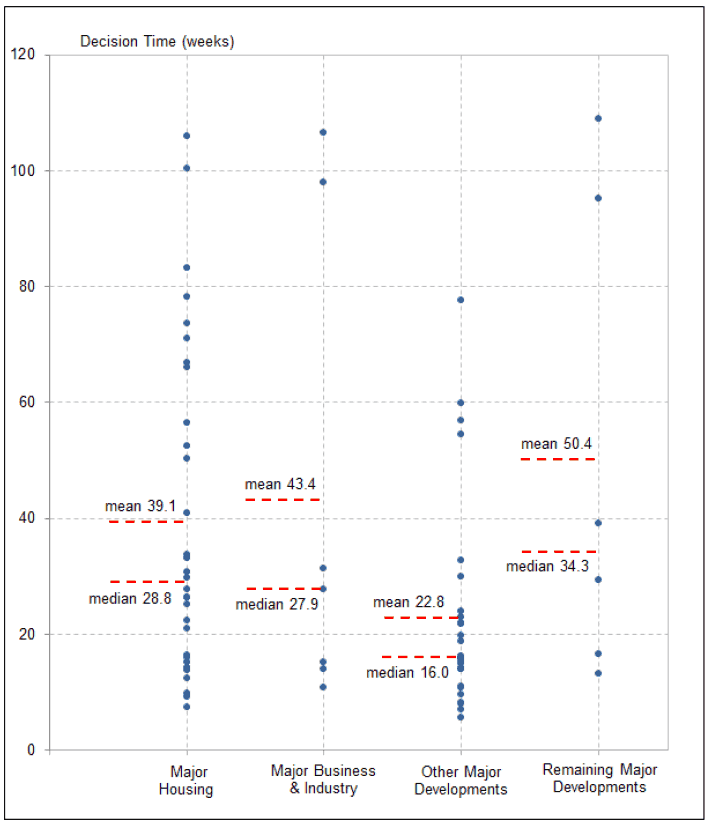Planning performance statistics: third quarter, 2016-2017
Summary of statistics on planning decision-making and timescales, as well as historic data going back to 2012 to 2013.
10. Annex A - Distribution of Decision Times for Major Applications
The following chart shows the distribution of the decision times for major applications that were concluded between October to December (quarter three) of 2016/17. Each dot represents one application (some dots land on top of one other).
Chart 35: Distribution of decision times for
major applications (excludes one legacy case)

The first column of dots in Chart 35 shows the distribution of decision times for the 32 major housing applications. The horizontal line at 39.1 weeks shows the mean and the horizontal line at 28.8 weeks shows the median decision time for major housing developments. Decision times range from 7.4 weeks to 105.9 weeks. 62.5% of the 32 major development applications were decided in a time that was quicker than the mean. The chart shows that the mean decision time has been influenced by a few lengthy decisions. There were ten applications with a decision time longer than one year. The lengthiest decision that took over two years for an approval was for a proposed residential development of 107 private dwellings and 12 affordable apartments in addition to ancillary works. A further decision that took almost 2 years was an approval for the erection of 53 detached dwellings with associated landscaping, roads and drainage infrastructure.
The second column of dots shows the decision times for the seven major business & industry applications. The horizontal line at 43.4 weeks shows the mean and the line at 27.9 weeks shows the median decision time for major business & industry developments. Decision times range from 10.9 weeks to 106.6 weeks. The application with the longest decision time (2.0 years) was an approval on a seven hectare site for the formation of business land and associated access, drainage and landscaping.
The third column of dots shows the decision time for the 28 major other developments. The category "other developments" includes any developments not falling wholly within any of the specific categories of development for minerals, housing, business & industry, waste management, electricity generation, fish farming. It includes, but is not limited to, retail, leisure and entertainment, education, healthcare, community facilities, transport interchanges, water and drainage developments and projects. It can also include mixed use projects. The horizontal line at 22.8 weeks shows the mean and the line at 16.0 weeks shows the median decision time for major other developments. Decision times range from 5.7 weeks to 77.7 weeks. 71% of the 28 major other development applications were decided in a time that was quicker than the mean. The longest decision time (1.5 years) was an approval for planning permission in principle for a mixed use development including residential, retail, financial, professional and other services, food and drink, business and/or hotel.
The last column of dots shows the distribution of decision times for the six remaining major developments. These include two applications for minerals, one application for waste management and a further three for electricity generation. The horizontal line at 50.4 weeks shows the mean and the line at 34.3 weeks shows the median decision time for these developments. Decision times are 13.3, 16.6, 29.4, 39.1, 95.1 and 109.0 weeks. The longest decision time was an approval for continued mineral extraction and proposed extension including recycling of imported waste and site restoration.
Contact
Email: Planning Statistics
There is a problem
Thanks for your feedback